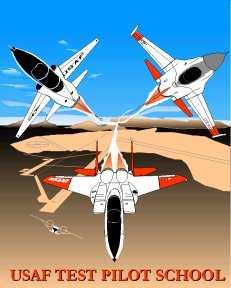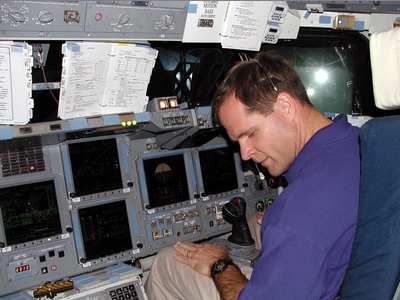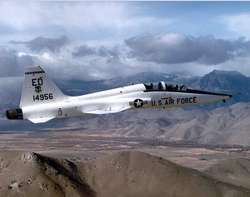 With the increasing push for a military space
force, Department of Defense officials are expanding the Air Force
envelope to include space education with an emphasis on military
application. In a recent memo, Secretary of Defense Donald Rumsfeld
wrote that all military departments must pledge space education at
every level. This will ensure space-qualified professionals have a
direct understanding of space activities and how space capabilities
are integrated into military operations.
With the increasing push for a military space
force, Department of Defense officials are expanding the Air Force
envelope to include space education with an emphasis on military
application. In a recent memo, Secretary of Defense Donald Rumsfeld
wrote that all military departments must pledge space education at
every level. This will ensure space-qualified professionals have a
direct understanding of space activities and how space capabilities
are integrated into military operations.
Officials at the U.S. Air Force Test Pilot School answered this
call by creating the first aerospace vehicle test course. The
school, which already has in-house expertise on "air-breathing"
aircraft testing, tackled an earlier U.S. Space Command request for
a space test program designed to teach testing of the Air Force's
first-generation, aerospace vehicles, said Maj. Kelly Greene, the
school's AVTC director.
"About five years ago, Space Command (officials) approached us
and said TPS grads were not meeting space needs because training
focused solely on airplane testing," said Greene. "They wanted us
to create a short course focused on spaceplane testing."
Kevin Ford (pictured below), a former school staff member and
now a NASA astronaut, put together the aerospace vehicle test
course that started in May 2000. Since then, the course is held
about once every 18 months, with the last class graduating in
November 2001. The next course is June 2 through June 28.

The course consists of approximately 80 hours of academics,
supplemented with projects, simulations, field trips and flying.
From the history of aerospace planes to the launch and return of
the space shuttle, the course covers a wide spectrum of aerospace
disciplines.
"We currently have two hours of spacecraft re-entry and one hour
on thermal protection systems," Greene said, "but due to the recent
space shuttle disaster, we are adding another hour to discuss
lessons learned from Columbia's destruction. We are always trying
to keep the course as updated as possible."

In addition, the course offers students the unique opportunity
to apply everything they learn in the classroom. "The students
receive a T-38 (Talon) and an F-16 (Fighting Falcon) ride, two
glider rides and a 'Vomit Comet' (pictured above) ride (where
students experience zero gravity)," said Greene.
The course includes field trips to the Palmdale Production
Facilities in Palmdale, Calif., the rocket labs and rocket launch
vehicle operations and test complex here, the Vandenberg Spaceport
at Vandenberg Air Force Base, Calif., and the Johnson Space Center
in Houston.
"When we visit the Johnson Space Center, every student gets a
ride in the full-motion space shuttle simulator; they experience a
simulated launch from Kennedy Space Center (Cape Canaveral, Fla.),
an emergency over the Atlantic Ocean and a landing back at
Kennedy," said Greene. "We haven't had a student miss the runway
yet."
 After
four weeks of instruction, the aerospace test course concludes with
a graduation exercise.
After
four weeks of instruction, the aerospace test course concludes with
a graduation exercise.
According to Greene, the students must design a test program on an
aerospace vehicle -- create a test matrix and plan, fly the mission
in one of NASA Dryden's simulators, collect data, compile the data
and present their final test report on graduation day. "The course
is fast paced, but well worth the effort," said Capt. Timothy
Jorris, 452nd Flight Test Squadron lead Global Hawk operations
engineer. He is a graduate of the first AVTC class and course
instructor.
Jorris said the course is extremely beneficial because it links
air and space academics, as well as demonstrates both disciplines
through hands-on flight test. "The transition from air to space is
happening rapidly, and those who attend this course can contribute
and fill the gap in the safe atmospheric and space test of our
future systems," said Maj. Bob Jones, NASA X-37 Orbital Vehicle
project manager and the only Air Force Reserve AVTC graduate.
All students must have a bachelor of science or master of
science degree in aeronautical, aerospace or astronautical
engineering, or have a strong background in one of these fields,
said Greene. Students must also be medically qualified to fly by
passing a Class-III physical. [ANN Thanks Capt. Catie Hague, Air
Force Flight Test Center Public Affairs]
 SpaceX to Launch Inversion RAY Reentry Vehicle in Fall
SpaceX to Launch Inversion RAY Reentry Vehicle in Fall Aero-News: Quote of the Day (04.23.24)
Aero-News: Quote of the Day (04.23.24) Aero-News: Quote of the Day (04.20.24)
Aero-News: Quote of the Day (04.20.24) ANN's Daily Aero-Linx (04.20.24)
ANN's Daily Aero-Linx (04.20.24) Aero-News: Quote of the Day (04.21.24)
Aero-News: Quote of the Day (04.21.24)






